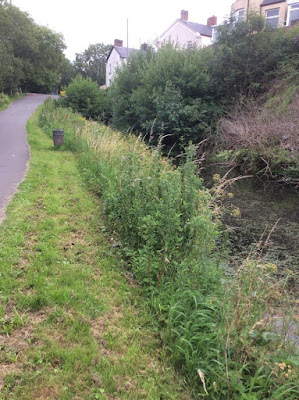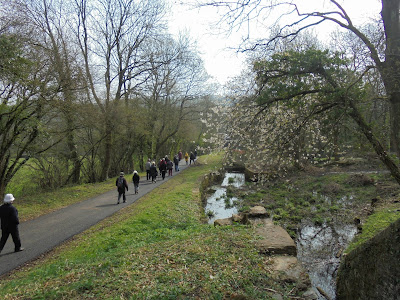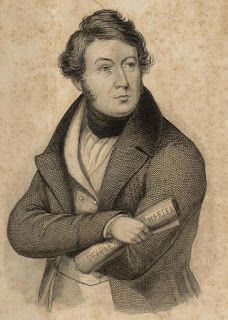The Crumlin Branch of the Monmouthshire Canal
The Crumlin Branch of the
Monmouthshire Canal
Many people
have been using the canal system to carry out lockdown walks and the Crumlin
branch of the canal is a favourite for people in and around Newport. Anne
Dunton has sent some photographs of her daily walk during lockdown. She usually
walks up to the top of Ridgeway in Newport and then takes the path down through
the woods of Allt-yr-yn Nature Reserve
to the canal. The reserve occupies the 32 acre site of the former Allt-yr-yn House and lido, and an old stone quarry. The lido has been turned into one of the ponds and only a few stones of the house remain. Thus Anne is walking through the grounds of Allt-yr -yn house. lt was situated to the west of Newport and
was surrounded by woodland and fields. She remembers swimming in Allt-yr-yn lido and this link is to a page from Newport Past. The lido was opened
by the Deputy-Mayor in 1934 and closed in the mid 1960s. Now the
remains are overgrown and obscured from view. Anne then arrives close to the bottom of the flight of 14 Locks which is one of the many amazing
features of historical importance in the Newport area. However we will not arrive at this section of the canal until we have looked at its history and some of the necessary construction feats.
The Monmouthshire Canal:
The canal
had two branches. One from just above Pontypool at Pontnewynydd and second
branch from Crumlin, and the two joined below Barrack
Hill. The Crumlin branch started at a
basin in Crumlin and flowed through
the villages of Newbridge, Abercarn and Cwmcarn where it is now underneath the
A467. From Cwmcarn the canal followed the side of the mountain above Crosskeys and Risca which
was a lock free section. It then passed through Rogerstone and down the 14
locks system and now passes under the M4 to meet up with the Pontnewynydd branch. In 2018 there was a plan to re-open sections of the Momouthshire and Brecon Canal to water transport. This was mooted by the Canal and River Trust in Wales a task which would mean dealing with many obstacles. The section into Newport is forever blocked and below is the entrance into the Barrack Hill tunnel and the section on the other side of the tunnel is lost beneath modern roads and city buildings.
 |
| The canal with the tunnel entrance in the distance |
 |
| The canal tunnel portal blocked with mesh. |
 |
Oil painting by Joseph Walter (1783-1856), The Monmouthshire Canal at Newport, Copyright Newport Museum and Art Gallery |
The Kingsway dual carriageway follows the route of the canal
to the now-filled-in Old Town Dock near to where the Transporter Bridge is
sited. Here is a painting showing the Newport end of the Canal. Note the canal
barge on the left and the removable walkway. The masts of sea going ships can
be seen on the river beyond. There would have been a sea lock to allow access
to the Usk.
Construction:
Work on the canal began in 1792 and the canal opened
for traffic from Crumlin to Abercarn in 1794. However, it was not
until 1796, with the completion of 14 Locks, that it was navigable to
Newport and that the two branches were fully operational. The Monmouthshire and Brecon Canal had been extended from Brecon to Gilwern by 1800 and
reached Pontymoile by 1812. The Crumlin branch was 11 miles (18 km) long,
rising 358 ft (109 m) through 32 locks. The working boats were
built of timber and were about 65 feet long with a beam of about 9 feet
carrying up to 25 tons of cargo. It was the Monmouthshire Canal Company with
its canal and tramroads which was responsible for the major growth of
Newport. In 1796 the company shipped 3,500 tons of coal from its
wharves on the river Usk, and by 1809 this had grown to 150,000
tons. In 1880 the Monmouthshire & Brecon Canals, as they were
then known, were taken over by the Great Western Railway and within 35 years
commercial carrying had all but ceased.
Tramroads:
When
studying the canal system, one cannot forget the tramroad system that supported
it and horse drawn drams brought iron ore, coal and limestone down to the canal
wharfs to be loaded for Newport. Tramroads ran from the Ebbw Vale and Beaufort
Ironworks and the Sirhowy Tramroad linked the canal with Tredegar. The routes
down to the canal were sometimes so steep that inclines were navigated by
stationery steam engines and balance mechanisms which took goods up and down
the hillsides. The Monmouthshire Canal Company constructed 9 tramroads
totalling 41 miles. (See Gwent County History vol. 4. page 58.) Timber and farm products were sent up the canal for pit props and to serve
the growing populations of the valley iron and coal towns.
The man who constructed the canal: Thomas Dadford Junior (1760-1801)
Feats of construction:
Now that we are able to travel further than 5 miles in Wales you will be able to travel up the canal to other sites of interest and there were several feats of construction on the Crumlin Branch. However not all of them remain visible today.
Reservoirs
Pen y Fan reservoir (click to access and scroll down for photos)
On this link you can read about his life. He died aged 40 while
still employed as engineer working on the Brecknock and Abergavenny Canal. Dadford died in 1801 at Crickhowell near
Abergavenny and was buried at St Teilo’s church at Llanarth. In 2013 a plaque of honour was unveiled to his memory at the 14 Locks Canal Centre.
Now that we are able to travel further than 5 miles in Wales you will be able to travel up the canal to other sites of interest and there were several feats of construction on the Crumlin Branch. However not all of them remain visible today.
Reservoirs
Pen y Fan reservoir (click to access and scroll down for photos)
It is an example of a canal feeder reservoir, built around 1794-6 as part of the engineering works for the Crumlin arm of the Monmouthshire Canal. These reservoirs were used to maintain the water level in the canal which was heavily used and had a large number of locks on it. The reservoir is formed by a large earth dam with stone facings, forming banks on three sides of a gentle slope. The outlet to the canal feeder forms a stone-lined, oval tunnel and a valve chamber is set into the bank above. The Hafodyrynys Reservoir is now the site of a playing field.
The Cwmcarn Reservoir was another feeder for the canal but was involved in a tragic disaster as the earth dam, 128m long and 10.7m high, burst catastrophically on 14th July 1875. It resulted in the devastation of the valley below and the loss of 13 lives listed below and obtained from HistoryPoints.org
- John Hunt, aged 49. Owner of the flannel factory.
- Mary Ann Hunt, aged 52. Wife of John Hunt.
- John Hunt, aged 22. Son of Mr and Mrs John Hunt.
- Letitia Hunt, aged 21, daughter of Mr and Mrs John Hunt.
- Elizabeth Hunt, aged 19. Daughter of Mr and Mrs John Hunt.
- James Hunt, aged 10. Son of Mr and Mrs John Hunt.
- Mary Jones, aged 15, factory hand.
- George Klein, aged 15, factory hand.
- Elizabeth Weeks, aged 17, factory employee.
- Howell Davies, aged 60. Resident of a cottage nearby.
- Margaret Davies, aged 38. Daughter of Howell Davies.
- John Davies, aged 34, collier. Son of Howell Davies.
Flannel was part of a widespread but small scale industry in Wales. Welsh flannel was promoted by Lady Llanover. As you can see from above it was basically a family concern with a few extra mill hands. It was probably sited there to rely on water power. The news became national and the Illustrated London News produced an illustration. See HistoryPoints.org. To read from the newspaper reports of the time click on the following link to Welsh Newspapers Online to read the account of the disaster in the Monmouthshire Merlin 23rd July 1875.
The aqueduct was built in the mid 1790s by Thomas Dadford junior to carry the
Crumlin arm of Monmouthshire Canal over the Nant Carn brook. A road bridge was built alongside and ran parallel to the aqueduct. Both were destroyed in the Cwmcarn Dam disaster of 1875 and subsequently rebuilt. The aqueduct now marks the northernmost surviving limit of the Monmouthshire Crumlin branch. It has a small single span, segmental arched passageway with squared rubble and ashlar quoins and voussoirs.
Fourteen Locks (Click on Coflein link and scroll down for images.)
Fourteen
Locks, also known as the Cefn Flight, is located on the Crumlin arm of the
Monmouthshire Canal at Rogerstone, near Newport. The flight of locks is one of
the steepest rises for a major run in the UK. The locks achieve a rise of 82
metres (268ft) in 800 metres (or half a mile). The run of locks includes a
series of embanked ponds, pounds, sluices and weirs to control the water
supply.
Until July 2012 British Waterways was the public corporation that cared for the 2,200-mile network of canals and rivers in England, Scotland and Wales. Its role was to ensure that the waterways could be used for all to enjoy, now and for many years to come.
On 2nd July 2012 the Government transferred inland waterways in England and Wales into a new charitable body, the Canal & River Trust.
The Fourteen Locks Canal Centre
 |
| A display of artefacts found along the canal on display in the Canal Centre. Some state MCC (Monmouthshire Canal Company and some MR&CCo (Monmouthshire Railway and Canal Company |
At the top of the lock system after lock 21 is the The Fourteen Locks Canal Centre. It is an interpretation centre situated after lock 21 at t the top of the flight. It was opened in 2002. It is a popular tourist centre providing information about the history of the canal but also about the amazing wild life habitat that the canal provides. The Monmouthshire and Brecon Canal conservation area was designated on 21 January 1998 and covers part of a canal network comprising two arms extending broadly north and north east from the Malpas area of Newport. It is managed by the Monmouthshire, Brecon and Abergavenny Canals Trust (MBACT), with an abundance of history, activity trails, family events and education days running throughout the year. The canal towpath is part of the national cycle route 47 and the Sirhowy valley walk.
The Volunteer Group
The canal could not survive without volunteers and the The Canal and Countryside volunteer group has been created by a partnership between the Fourteen Locks Canal Centre and Newport City Council, with Mbact running the centre and funding from the heritage lottery fund. The project has really taken off and many skills are needed.
Restoration began on the locks in 2002 with the top lock 21. All the gates were made by British Waterways to individual measurements.The
flight consists of unusually deep masonry chambers that are grouped in pairs
with short intervening pounds. The variety of stones in the chamber walls has led to the view that stones were recycled and there is a suggestion that some might have come from Newport Castle.
 |
| Looking towards the Canal Centre from lock 21 the top lock in the flight, which was restored in 2005. (MAA 2019) |
 |
| Note the bollard for tying up boats (MAA 2019) |
Click lino here to see a painting by J. S. kerslake from Newport Museum and Art Gallery's collection.
 |
| (MAA 2019) |
 |
| Lock 11 is known as the mystery lock. It has shelves on either side and its purpose is uncertain. (MAA 2019) |
 |
| Lock 20. (MAA 2019) |
 |
| The M4 motorway (Anne Dunton 2020) |
 |
| Access to the Nature Reserve (Anne Dunton 2020) |
Once one walks under the M4 motorway the canal has several more locks before it joined with the Pontnewynydd branch. The first is the Allt-yr-yn Lock, then the Little Lock, the Waen Lock and the Gwasted Lock which was named after the area of level ground to the left of Malpas, There was a similarly named lock on the other branch of the canal. However there is a confusion over spelling (see below). Along this stretch is the footbridge that takes you through into the Nature Reserve which is where Anne started her walk. The Gwasted Lock is the last lock and has been restored and there is a bridge close to it. By removing the ivy the name of the lock could be seen 'Gwasted no. 2.' (Spelled Gwasted although sometimes spelled Gwastad).








Comments
Post a Comment